Implant prosthetics – basic information

IMPLANT-SUPPORTED Crown
Implant prosthetics is a field of dentistry that combines implantology and prosthetics. It deals with the restoration of missing teeth based on intraosseous implants, rather than the patient’s own teeth. By reconstructing teeth on implants, we can achieve a lasting aesthetically pleasing effect and improve the functioning of a masticatory system that has been disturbed by loss of teeth. Prosthetic solutions based on implants look like natural teeth, are stable and provide a sense of security and freedom in every activity.
Applied solutions
Treatment planning
Consultation in order to choose the best implant prosthetic solution is based on accurate diagnostics (computed tomography, assessment of bone and occlusion).
Solutions for one missing tooth
In the case of one missing tooth, the best solution is to insert an implant. If for some reason this is not possible the alternative in most cases is a prosthetic bridge.
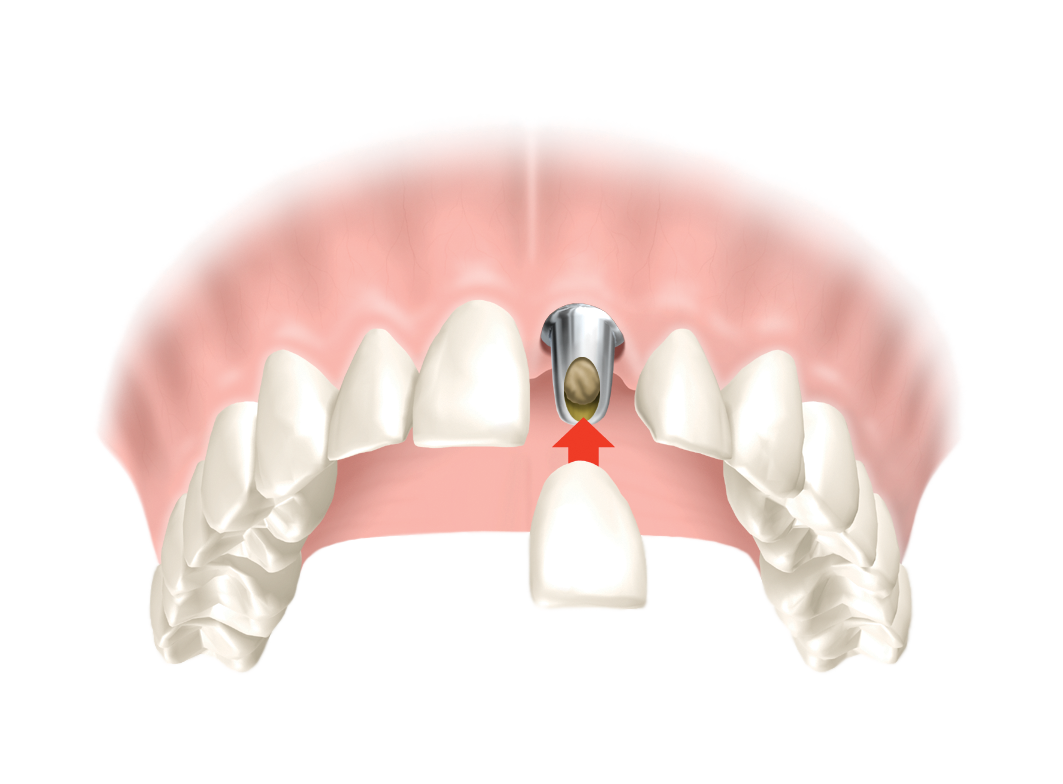
implant-supported crown
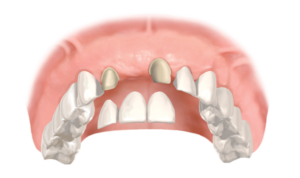
Bridge on PATiENT’S OWN FILED DOWN teeth
Restoring a missing tooth (by inserting the implant) relieves neighbouring, healthy teeth, restoring the natural and even distribution of forces acting on the bones. In addition, implantation does not require filing down healthy teeth, which is necessary to form the basis for traditional bridges. Implants serve patients much longer and are not susceptible to decay, in contrast to teeth on which a bridge is attached.
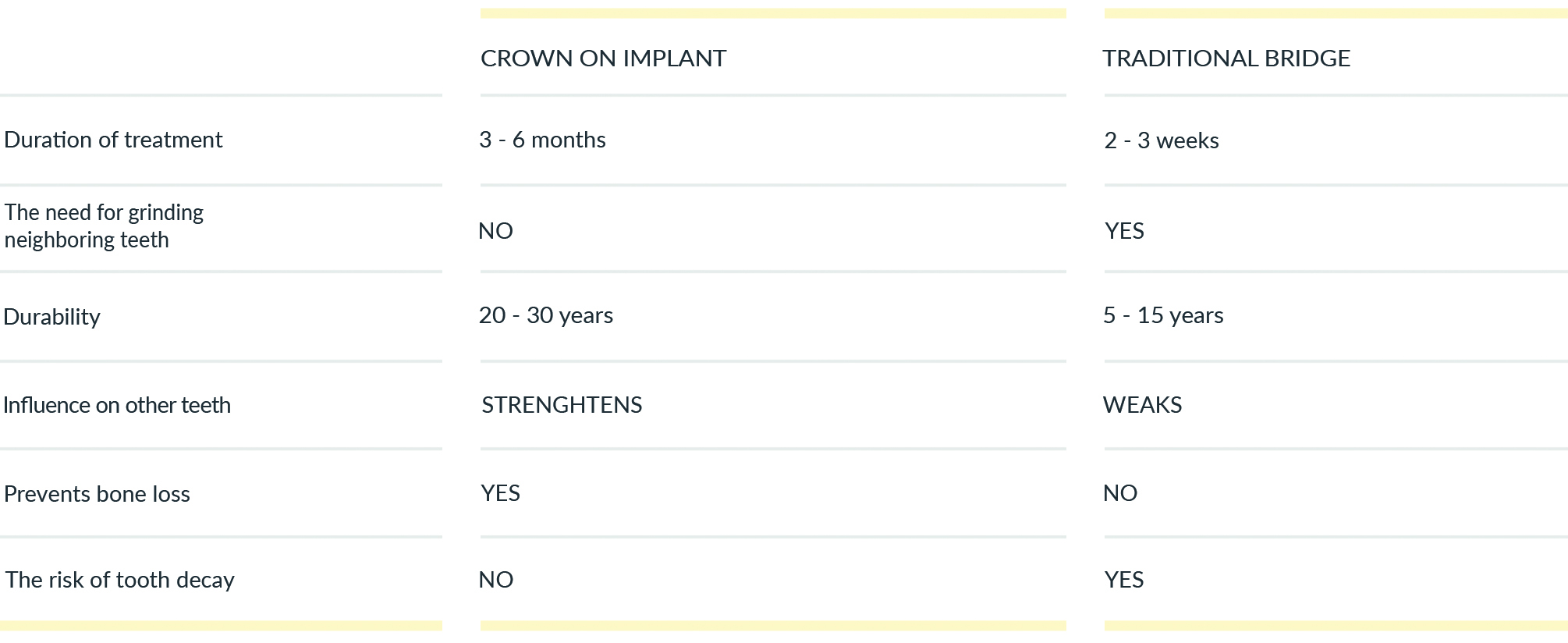
Applied solutions in case of several missing teeth
As in the case of a single missing tooth, the best solution is implant-based prosthetic treatment. If it is not possible to carry out this procedure, it is possible to reach for solutions in the field of traditional prosthetics, such as a bridge supported on several points or a removable prosthesis.
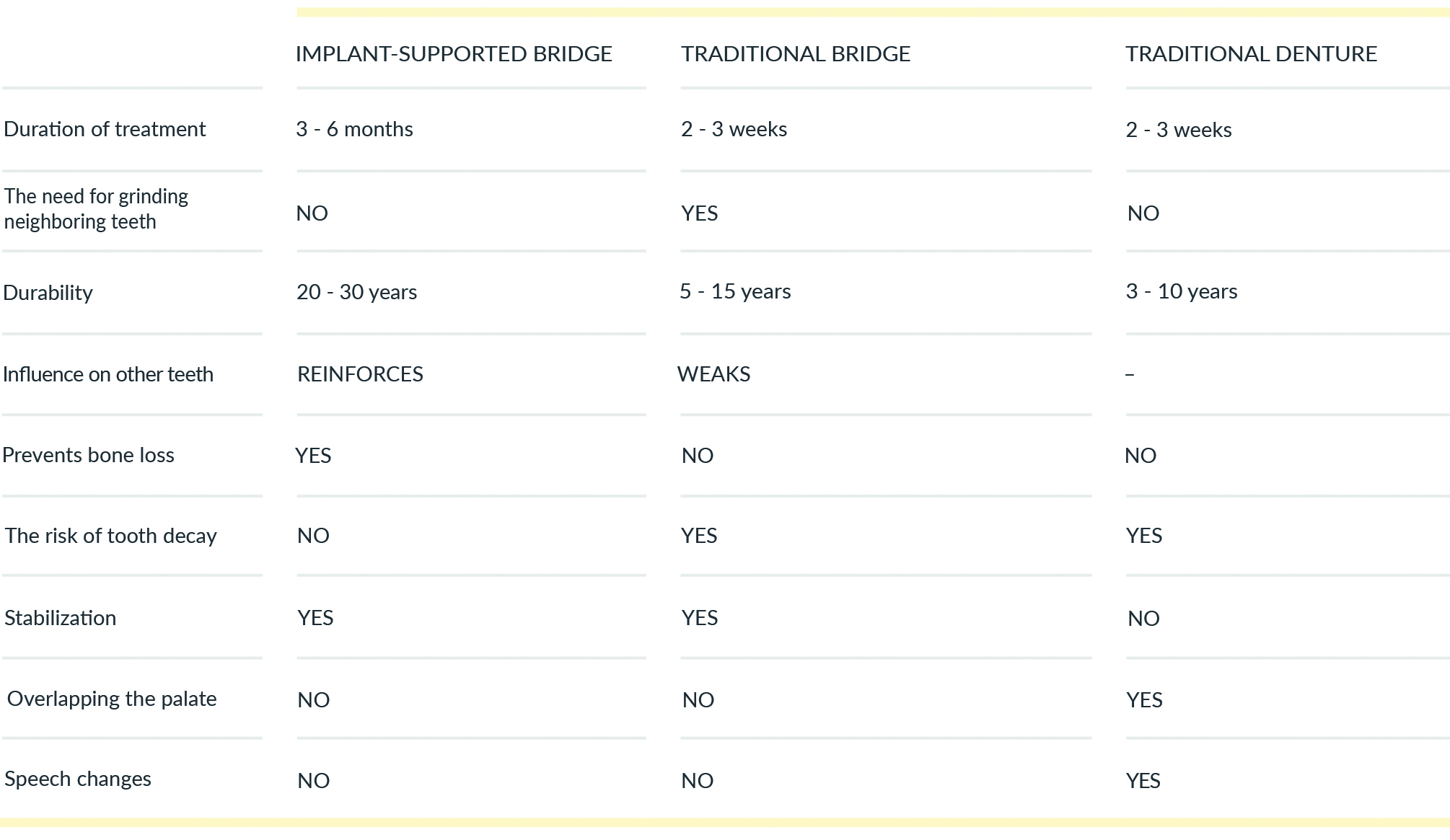
What is an implant-supported bridge?
An implant-supported bridge involves at least three connected crowns suspended between (at least two) implants, which form a stable foundation for them.
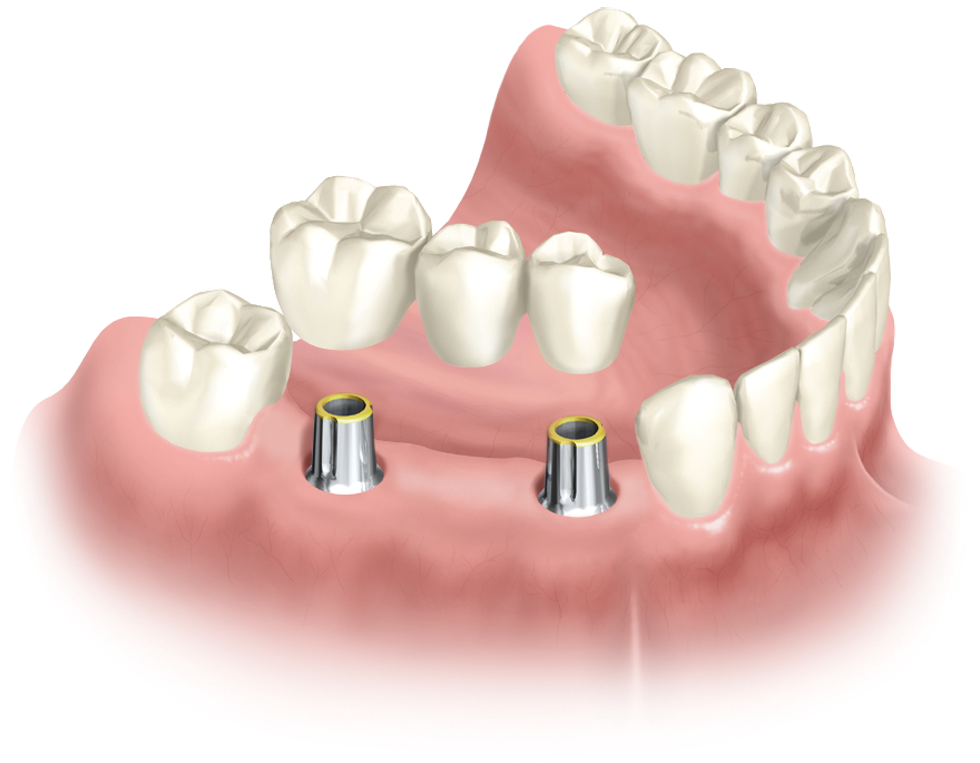
TWO IMPLANT-BASED Three-UNIT bridge
An implant-supported bridge is the best solution if you are missing several adjacent teeth. It is tailored to the individual so that its shape and colour match the patient’s remaining natural teeth. The difference is practically imperceptible. The use of implants prevents bone loss, thanks to which neighbouring teeth remain intact. An additional advantage of this solution is that there is no need to file down the patient’s healthy teeth, thus preventing irreversible damage to them. In contrast to an implant-supported bridge, a removable prosthesis may require removal and reapplication as often as several times a day.
What is a prosthetic abutment?
In order to be able to embed the crown on the implant, a kind of pillar is needed, which will connect a concave implant with a „cap” in the form of the crown. This role is played by an abutment, which is placed in the implant, and on which the prosthetic works are embedded. The choice of abutment depends on the patient’s individual treatment plan; it can be made of titanium or zirconium.
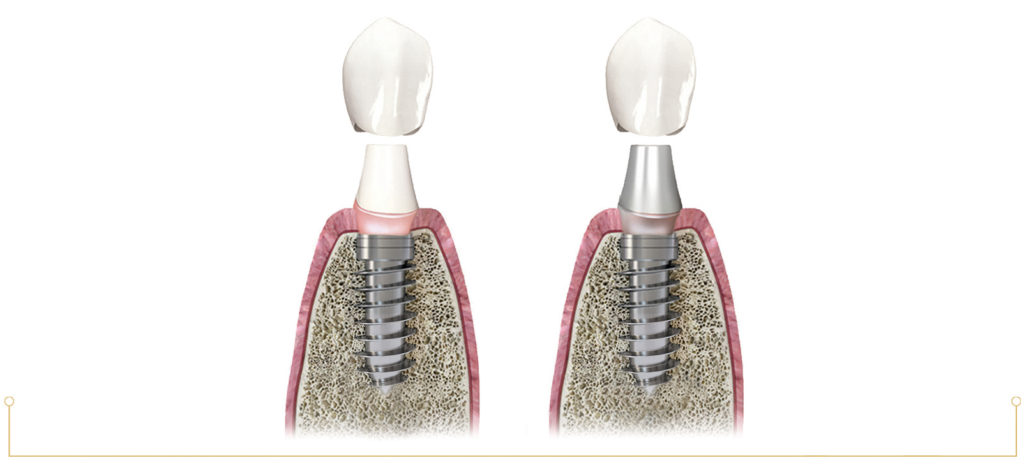
zirconium abutment titanium abutment
Applied solutions in cases of complete toothlessness
In cases where all teeth are missing, implant-supported prosthetics offers a variety of prostheses. Thanks to modern implantology it is possible to make stable prostheses based on implants.
Traditional prostheses hinder mastication and chewing of many types of food, and can also interfere with speech. Having a traditional prosthesis causes bone atrophy, which leads to changes in the appearance of the face. To regain an attractive appearance and restore the functions of the oral cavity in cases of significant loss of teeth, it is best to choose an implant-based prosthesis.
An implant-supported prosthesis is extremely stable due to its being fixed on two, four or more implants. The dental prosthesis performs the functions of missing teeth, thanks to which it is possible to chew all foods without anxiety. The patient will not feel the difference between the prosthesis and natural teeth.
Implant-supported prosthesis
Implant prosthetics at the Cichoń Dental Centre involves:
- Removable dentures placed on two or more implants, using so-called locators that are attached to implants. Thanks to the locators, the patient can independently and safely remove the dentures for daily hygiene.
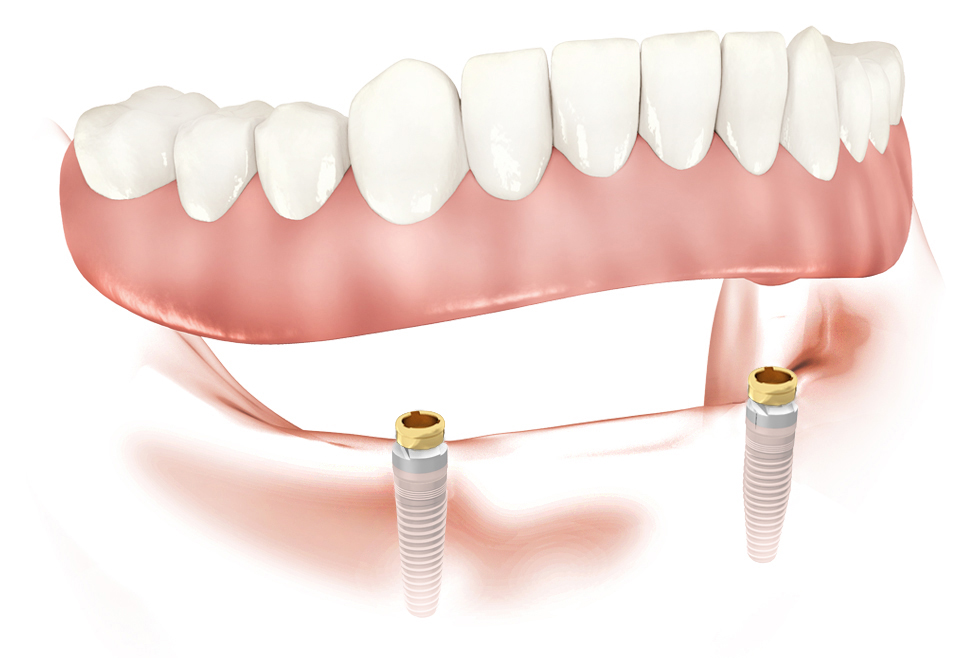
LOCATOR- AND IMPLANT-SUPPORTED COMPLETE REMOVABLE PROSTHESIS
- Implant-supported or bar-retained prosthesis. The prosthesis is attached with an individually tailored bar with abutment clamps that hold the restored teeth.
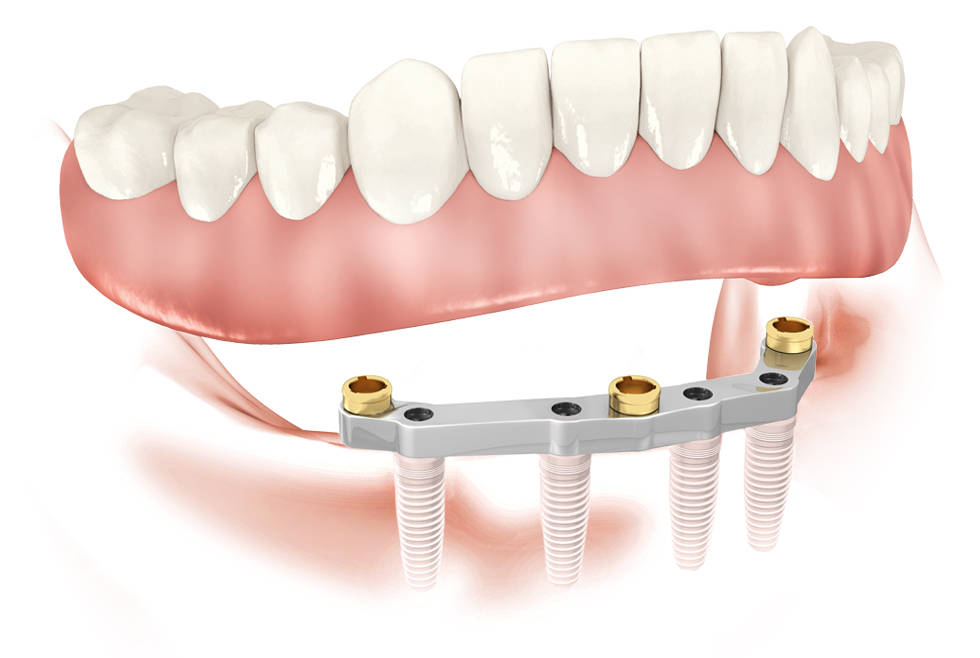
bar-retained AND IMPLANT-SUPPORTED COMPLETE REMOVABLE prosthesis
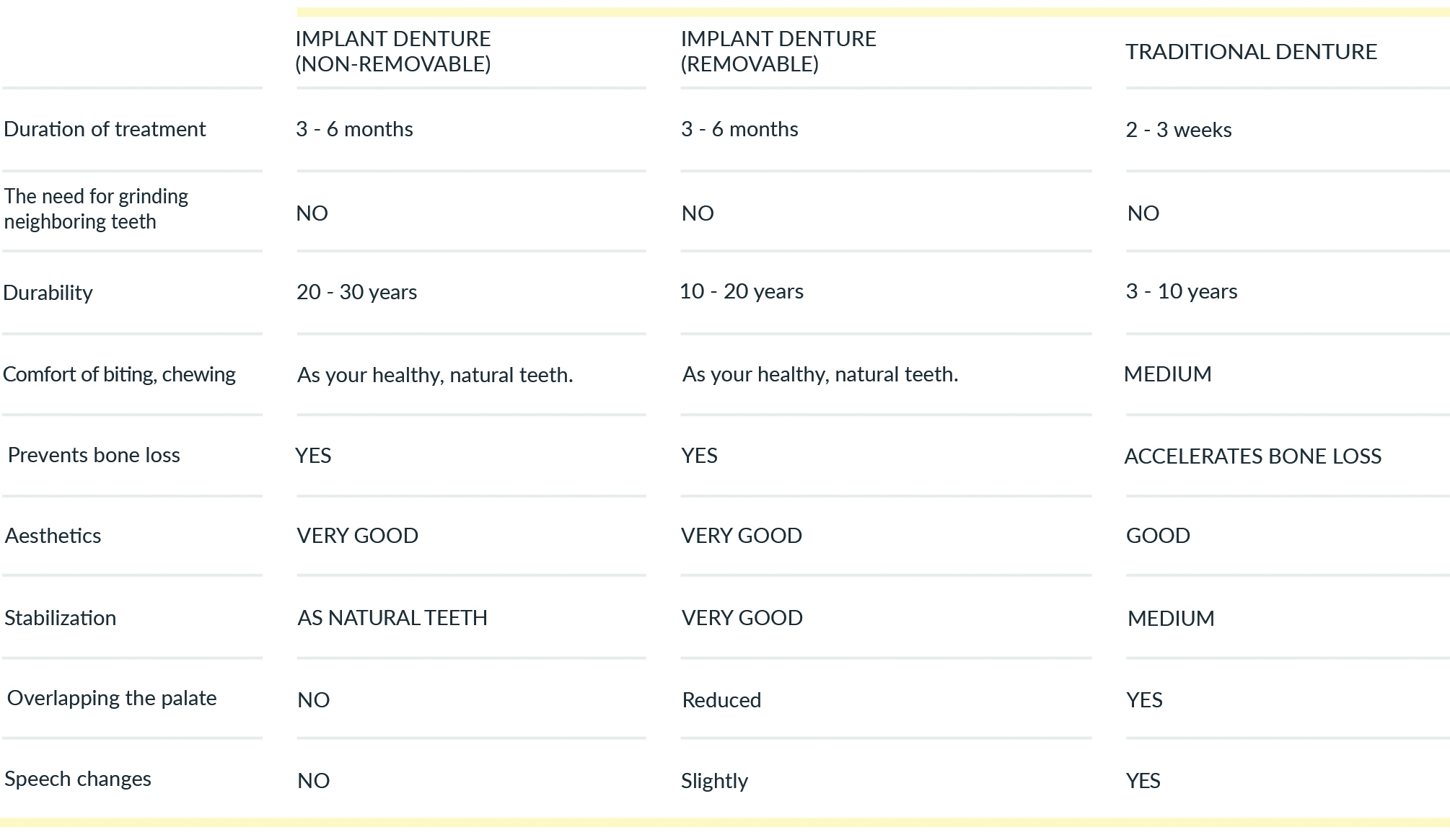
In our clinic we offer you two proven prosthetic methods:
- The All-on-4 method, used in the lower jaw of the patient, involves inserting 4 implants and placing the prosthesis on them. The technique can be used in cases of heavy bone loss.
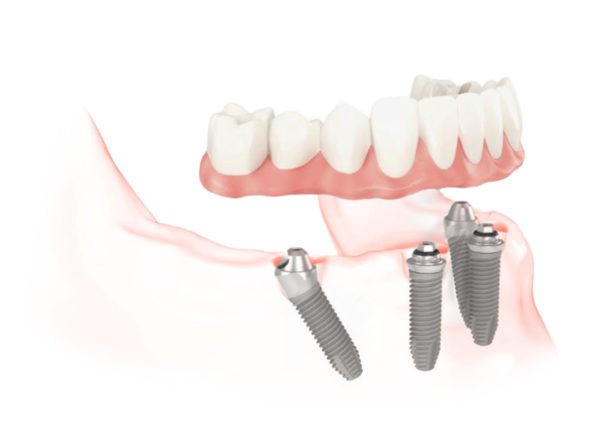
FOUR-IMPLANT-SUPPORTED fixed LOWER prosthesis
- The All-on-6 method, like the All-on-4 technique, is sometimes used in cases of heavy bone loss. It involves inserting 6 implants and placing dentures on them. It can be used in the patient’s lower or upper jaw.
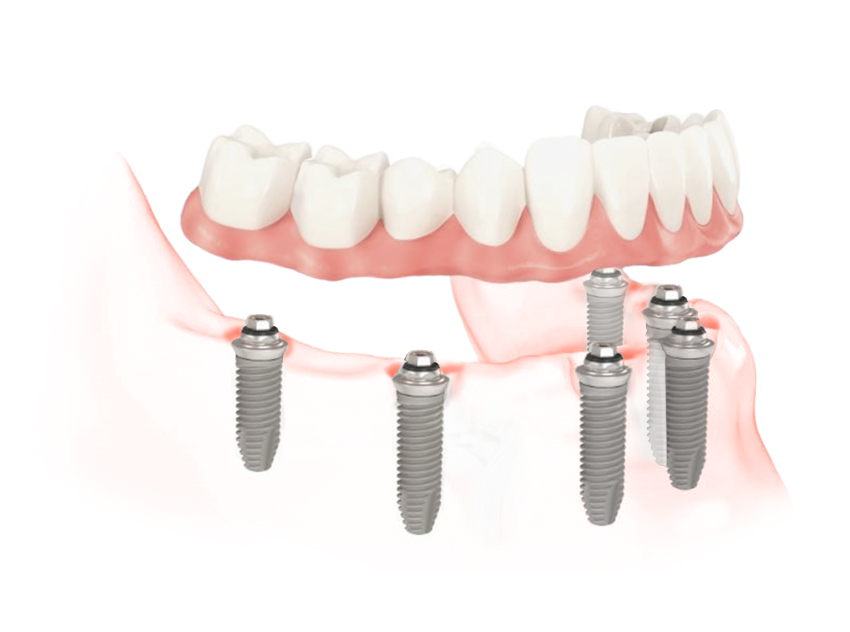
six-IMPLANT-SUPPORTED FIXED PROSTHESIS
For patients who care about complete comfort and the possibility of the best functional rehabilitation, ceramic bridges supported on 8 implants in the maxilla and 6 in the mandible are recommended.
Implant-based prosthetic reconstruction
Prosthetic works on implants are made of the same materials as dental restorations. We invite you to familiarize yourself with the extensive description of solutions used in our Centre. Learn more…
Frequently asked questions
Is fluoride safe?
Fluoride is a toxic element, but only in very large quantities. The doses contained in toothpastes and fluoride varnishes used in accordance with recommendations are completely safe.
Why are implants considered a better solution in the absence of teeth than a removable prosthesis?
Indeed, implants are a better solution than a prosthesis. All the forces accompanying food chewing are transferred to the crowns of our teeth and then to their roots. The implant is screwed into the bone, with which it integrates perfectly, meaning it replaces the natural root 100%. Dentures are far less comfortable. First of all, the prosthesis is mobile and therefore it will never be as stable as implant work.
Advantages of dental implants:
• provide a strong and stable foundation for artificial teeth that look, feel and function like real teeth
• help to provide attractive and aesthetic smile, as well as keep face shape (they stimulate bone tissue and gums)
• help to maintain the healthy condition of neighbouring teeth by eliminating the use of a clamp and the need to file down adjacent teeth for support under the bridge or prosthesis
What is implant-supported prosthetics? What is implant-based prosthetic restoration?
Implant-supported prosthetics is a crown, a bridge or a prosthesis attached to an implant. The implant is a titanium screw inserted into the bone, which replaces the root of the lost tooth. After its introduction, it is necessary to wait some time until the implant integrates with the bone and then the next stage, prosthetic reconstruction, can begin.
Is it true that you should fill in a missing tooth as soon as possible?
Yes, it’s true. The place left by the removed tooth is referred to as the “destructive gap”, because at the moment of tooth loss, the distribution of mandibular movement forces along the dental arches gets disturbed. A destructive process begins, which can have irreversible consequences:
– due to the tilting of the teeth in the direction of the gap between the teeth there are breaks – unsightly diastema, which cause inflammation of the gums;
– during the chewing of food, forces that cause the teeth to bend towards the gap are released, which disturbs the symmetry of the smile;
– the bone disappears in the area of the extracted tooth, and the next stage of this process is gum atrophy, which can significantly hinder the performance of aesthetically satisfying prosthetic restoration;
– due to lack of contact with the neighbouring missing tooth, teeth systematically move, which can lead to overloading (dental trauma knot), loosening, and in extreme cases even to the need for further extraction;
– moving of teeth leads to an abnormal occlusion, which may result in changes in the temporomandibular joint.
What is the best way to replace a missing tooth?
One of the best ways to compensate for missing teeth is with an implant-supported prosthesis in the form of crowns or bridges on implants. The advantage of filling missing teeth with implants is, among others, that there is no need to grind the teeth adjacent to the gap. In addition, implant treatment prevents bone atrophy in the absence of a tooth.











